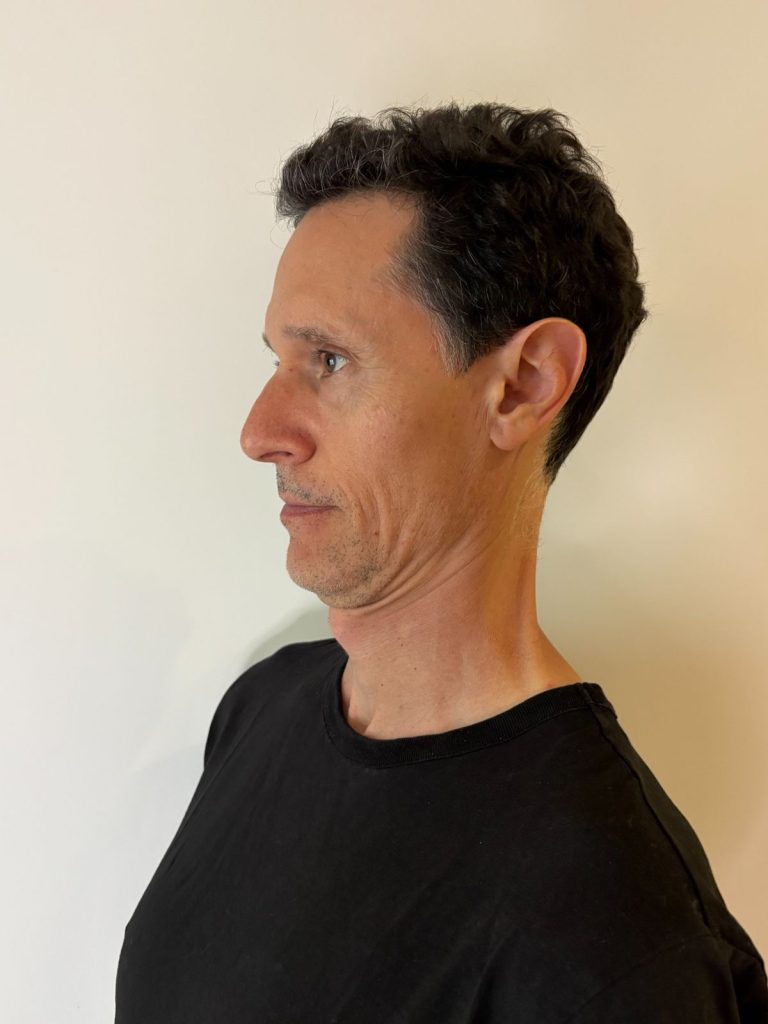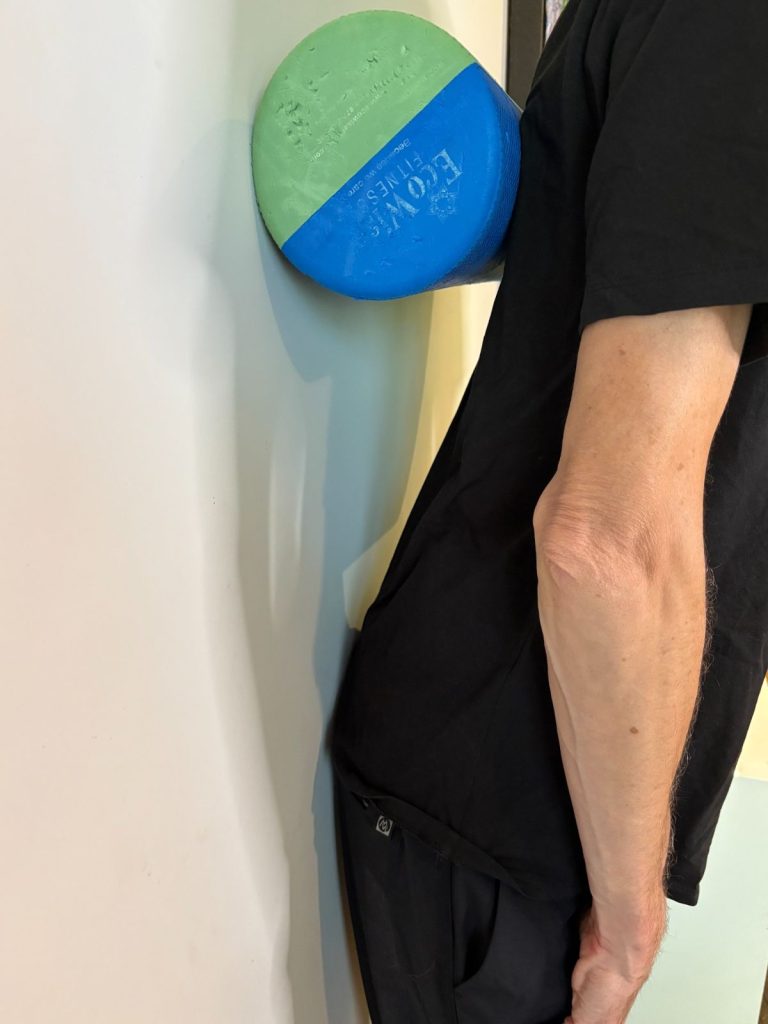Swayback posture can sneak up on anyone with all the sitting and screen time we do these days. Take a second right now to assess your posture: are your shoulders rounded forward? Is your head starting to creep out in front of your body? If so, you might be slowly training yourself into a swayback posture without even realizing it.
Here’s why that matters: even a 2-inch forward shift of your head adds the equivalent of 20–30 pounds of stress to your neck and upper back. OUCH. No wonder swayback posture can cause pain, stiffness, muscle tension and spasm, and fatigue over time.
As a chiropractor in Toronto, I often see patients struggling with rounded shoulders, forward head posture, and constant neck and upper back tension. One of the most effective ways to counteract this postural shift is the Titanic swayback posture exercise — a simple but powerful exercise that addresses and corrects multiple postural faults all at one time.
Why the Titanic Exercise?
After more than 25 years at Transform Chiropractic in Toronto, we’ve worked with hundreds of patients struggling with swayback posture or hunched posture. There are plenty of individual exercises that target parts of the postural complex, but the Titanic stands out because it does all of the following in one movement:
Corrects forward head posture
Reduces excess rounding (kyphosis) in the upper back
Counters the swayback shift of the mid-spine
Repositions the forward-shifted pelvis
In short, it’s time-efficient, powerful, and effective. Yes, it can be challenging at first — especially if your posture has been stuck for years — but it’s one of the best investments you can make in your spine.

What Is Swayback Posture?
Swayback posture (sometimes also called double cross syndrome) is when:
Head and neck jut forward (forward head posture).
Upper-back rounds into a hunch (hyper-kyphosis), with shoulders rolling forward.
Mid-spine shifts backwards (swayback), counterbalancing the forward shift of the head.
Pelvis shifts forward, placing increased stress over time on the lower back and hips.
Over time, this posture can cause a cascade of symptoms:
Neck pain & headaches
TMJ pain
Upper back stiffness & pain
Shoulder pain and rotator cuff tears
Arm pain, carpal tunnel
Herniated discs
Low back pain and sciatica
Awful, right? The good news is — with consistent effort, you can start reversing this pattern with the Titanic Exercise for swayback posture.

Step-by-Step Instructions: Titanic Swayback Posture Exercise
Step 1: Foam Roller in Midback
Place a small foam roller or wedge horizontally in your midback, roughly at mid shoulder blade level.
Stand leaning against a wall so the roller pushes your midback forwards.
This first step helps to counteract the slouching and thoracic rounding (the swayback portion).
Step 2: Neck Retraction / Chin Tuck
This simple chin tuck is a cornerstone of any program designed to correct swayback posture.
While keeping the foam roller in place, start to pull your chin straight back (like making a double chin), into a chin tuck / neck retraction exercise.
Try to avoid tilting your head back into extension…keep your chin horizontal.
Ideally bring your head back touching the wall or as close to it as you comfortably can.
This helps to minimize the forward head posture component and also serves to release tension in your upper neck (suboccipital) muscles.

Step 3: Open Chest & Shoulders
Bring your arms out to the sides, horizontally so your hands come close to or touch the wall.
Roll your shoulders slightly back as you do this to open your chest.
Go gently — if you’ve had this posture for years, it will take time to release your tight pecs and shoulders. Don’t force this, take your time so you don’t aggravate your rotator cuff.
Step 4: Hips & Pelvis Back
Gently push your hips/butt back toward the wall. It doesn’t need to touch, just move towards it.
Don’t force it…change will take time.
This movement helps to correct the forward pelvic shift so common with swayback posture.

How Long & How Often?
Hold each rep for 10–15 seconds, working up to 30–60 seconds.
Perform 5–10 reps per set, with 2–3 sets daily.
Remember: consistency beats intensity. This posture didn’t happen overnight, and it won’t be corrected overnight. Small daily steps lead to big long-term changes.
Common Mistakes to Avoid
Forcing neck extension (chin raising in the air) instead of straight retraction.
Over-pushing your pelvis into the wall.
Trying too hard and forcing movements — stick with 70–80% effort.
Ignoring sharp or acute pain (stop if this happens!).
Extra Tips for Success
Expect some mild tension in your chest, shoulders, or midback — this is normal.
Practice in front of a mirror at first to check your form.
Use a partner for feedback, or take a quick photo/video.
Don’t rush — poor posture takes years to form, and weeks to months to correct.
- Making this a daily habit is one of the best ways to fix swayback posture long-term.
FAQs
Q: How long does it take to see results?
👉 Many patients notice improvements in posture awareness within weeks, and small changes almost immediately. Bigger changes take several weeks to months and require consistency.
Q: Is the Titanic Exercise safe if I have disc or arthritis issues?
👉 Typically yes, but avoid acute/sharp pain. If unsure, consult a posture specialist, like a Toronto chiropractor.
Q: Do I need a foam roller?
👉 Ideally yes. A rolled towel or mat can work, but a foam roller is denser and helps you see results faster.
The Bottom Line: Correcting Swayback with the Titanic Exercise
The Titanic Exercise for swayback posture may feel awkward at first — but if you stick with it, it can transform your hunched posture, helping you look and feel better.
If you’re struggling with swayback posture or pain and want a more detailed analysis plus care recommendations, feel free to reach out at Transform Chiropractic in Toronto, or visit our page on posture correction in Toronto.
Dr. Byron Mackay
Transform Chiropractic – Posture Correction




